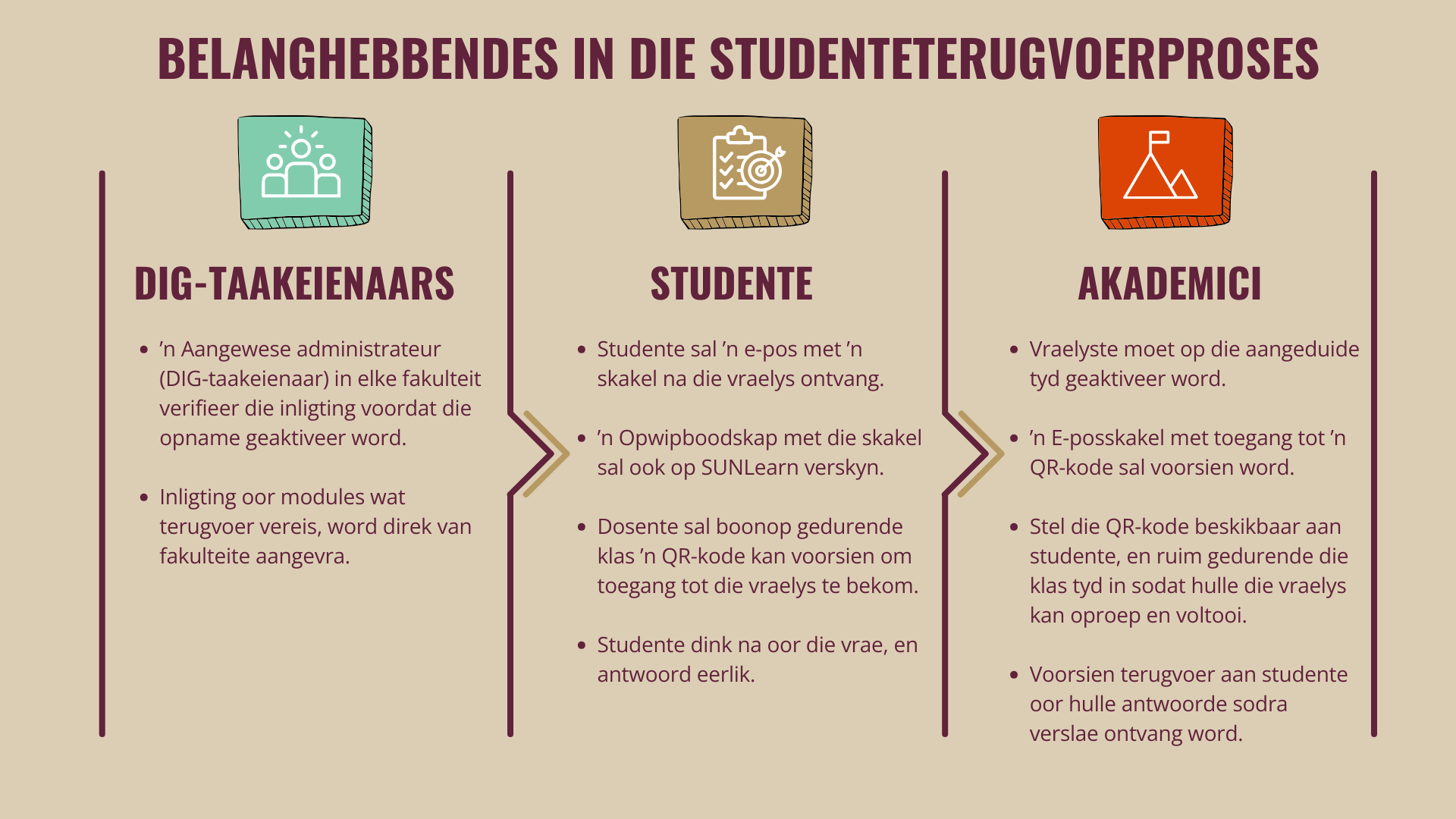Die Onderrig- en Leerbeleid van 2025 (punt 7.4.4) noem studenteterugvoer as een van 'n verskeidenheid toepaslike databronne wat gebruik kan word vir die evaluering van OLA, wat op toepaslike kriteria vir gehalteversekering berus. Voorbeelde van sulke bronne is klaskamerassesseringstegnieke (KAT's), terugvoer van kollegas, self-evaluering en -besinning, en literatuur.
Die Onderrig- en Leerbeleid beklemtoon onder meer die volgende rolle en verantwoordelikhede van akademici en studente:
Akademici:
8.1.7 Samel terugvoer oor OLA vroeg en dikwels in en reageer daarop om alle studente se leer te verryk en akademici se professionele leer in hulle OLA-rol te rig.
Studente:
8.2.4 Verskaf, op versoek, omvattende en opbouende terugvoer oor modules, programme en dosente ter ondersteuning van hulle eie leer, akademici se professionele leer vir hulle OLA-rol, en die verryking van die module (hetsy vir formatiewe of summatiewe doeleindes).
Studenteterugvoer word by twee kerngeleenthede elke semester ingesamel: een halfpad deur die semester, en die ander aan die einde van die semester. Die verskille tussen hierdie twee terugvoergeleenthede word hier onder uiteengesit:
| Terugvoer halfpad deur die semester | Terugvoer aan die einde van die semester |
- Terugvoer is suiwer formatief
- Resultate word slegs aan die dosent(e) van die module bekend gemaak
- Die opname-instrument bestaan uit drie oop vrae
- Die bedoeling is om aan te dui hoe studenteleer gedurende die res van die module verbeter kan word
| - Gelykstaande aan ons huidige formele terugvoer
- Die opname-instrument bestaan uit agt vrae met Likertskaal-antwoorde
- Resultate word aan die dosent en sy/haar lynbestuursfunksie bekend gemaak
|
Tydsberekening is belangrik: Uit ervaring blyk dit dat deelnamesyfers vir opnames wat eers ná die einde van klasse vir 'n module gedoen word, aansienlik laer is as dié wat voor die einde van 'n module onderneem word. Studente behoort verkieslik die geleentheid te hê om hulle behoeftes en kwessies te opper voordat klasse vir die module klaarmaak. Dit is belangrik om sulke kwessies met hulle te bespreek, en te toon dat dosente hulle terugvoer op prys stel en daarop reageer.
Belanghebbendes in die studenteterugvoerproses:

Verspreiding van verslae:
Nadat die vraelys gesluit het, sal die Studenteterugvoerkantoor binne sewe dae terugvoerverslae deur die SUNFeedback-stelsel versprei. Hierdie verslae gaan aan die volgende belanghebbendes:
- Individuele dosente
- Departementshoofde
- Visedekane (Onderrig en Leer)
Programterugvoervraelys:
Let wel: Die proses vir die beoordeling van die programterugvoervorm vind nie meer plaas nie. Die vorm is tot verdere kennisgewing nié beskikbaar vir gebruik nie.

